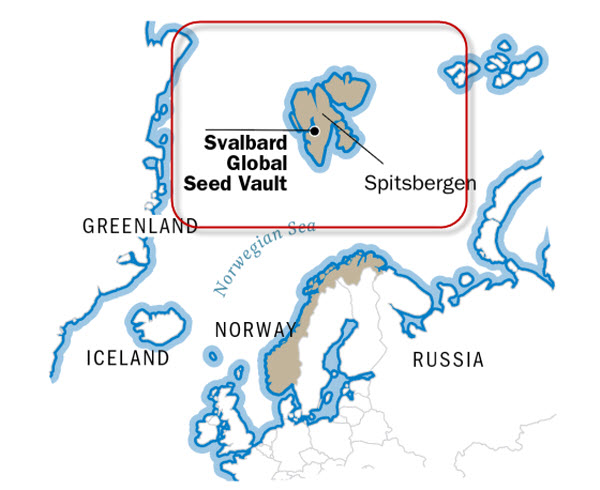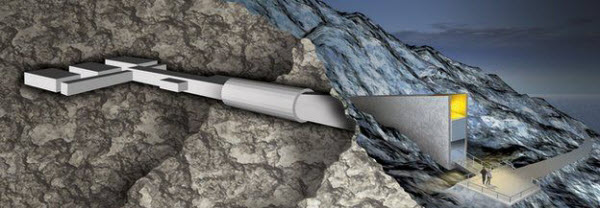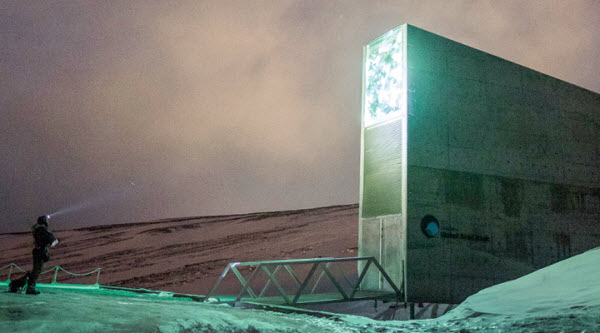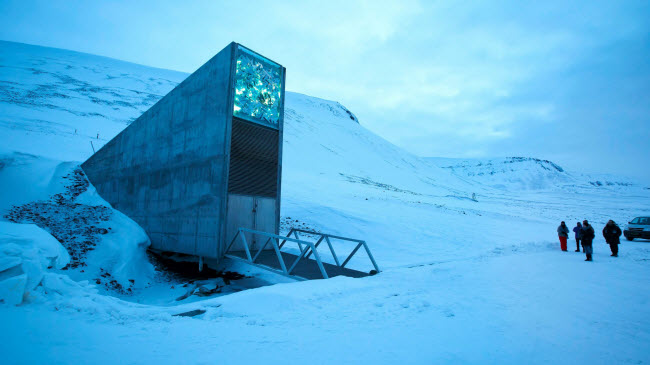The Svalbard Global Seed Vault, also known as a giant seed bank, is an underground vault located on the Norwegian island of Spitsbergen. This remarkable facility is designed to securely store countless varieties of seeds from around the world, safeguarding both the most common and the rarest varieties.
A Story of Conservation
Are you familiar with the Spitsbergen site? Situated about 1,120 km from the North Pole on an island north of Norway, this location provides the ideal conditions for this conservation project. To achieve this, the building housing all these seeds was dug into the side of a sandstone mountain. With a depth of 120 meters and a 100-meter-long corridor leading to three rooms, each with a surface area of 256.1 m², the vault has a total storage volume of nearly 1,500 m³.

This incredible fortress is not solely under Norwegian control. It is managed under a tripartite agreement between the Norwegian government, the international organization “Global Crop Diversity Trust,” and the Nordic Genetic Resource Center (a cooperation among Scandinavian states under the authority of the Nordic Council of Ministers). A feasibility study conducted before construction demonstrated that the vault could preserve seeds of most food crops for hundreds of years. Some seeds, especially those of important crops, could even survive longer, perhaps thousands of years.
More Than 10,000 Samples
It all began in 1984 in an abandoned coal mine, where the Nordic Genetic Resource Center stored the genetic material (genetic resources, DNA of an organism, and collections of this genetic material) of Scandinavian plants in Svalbard. Over several years, the genetic bank stored more than 10,000 samples of over 2,000 cultivars (varieties of a plant species obtained through artificial selection for cultivation) from 300 different species.
Another strength of the project was the double backup that took place for a few years through the cross-exchange of seed samples between South Africa and the Scandinavian collection. Both collections, Scandinavian and African, were transferred to the current seed bank.

More than 20 years later, construction began. On June 19, 2006, the first stone was laid in the presence of the Prime Ministers of Norway, Sweden, Finland, Denmark, and Iceland. The official inauguration followed on February 26, 2008. Nearly 11 years later, on March 27, 2017, the Arctic World Archive, a second bunker, was built on the island of Spitsbergen. This one is intended to protect data such as texts, photos, or videos.
Let’s not forget the incident in May 2017 when the vault was flooded. The permafrost had melted due to climate change. Fortunately, the seed reserves were not damaged.
A High-Security Project
All these precious seeds, preserved in this vital site for biodiversity conservation, require multiple security systems. First, the seeds are packed in special four-layered packets that are heat-sealed to prevent them from molding. Then, the facility is managed by the Nordic Genetic Resource Center. It should be noted that there is no permanent staff on-site.

The absence of tectonic activity and the presence of permafrost make Spitsbergen an ideal location for conservation. Situated 130 meters above sea level, the vault remains dry even in the event of ice melt and sea level rise. To maintain the seeds at -18 degrees Celsius, according to international conservation standards, locally mined coal is used to power refrigeration units. Even if equipment failure were to occur, it would take several weeks for the temperature to rise to −3 °C, the natural temperature of the surrounding mountain rock.
Renewing for Better Preservation
The main idea is not to let the seeds age until they reach their maximum conservation time. The Svalbard vault is useful to researchers. It serves as a backup for seeds conserved in standard gene banks. When the stock of these banks dwindles or becomes too old, the seeds are sown and the stock is renewed. Part of the new seeds is immediately sent to Svalbard, which always has the freshest seeds possible. The Svalbard stocks are therefore regularly renewed, on average after a few decades.

It is estimated that about 1.5 million different varieties of agricultural seeds still exist worldwide. The diversity and number of seeds stored in Spitsbergen depend on the number of countries participating in the project. The facilities have a storage capacity of 4.5 million seeds. The first seeds left the port of Lagos in Nigeria. 7,000 varieties of cowpea, maize, soybean, and groundnut seeds, weighing 330 kilograms and packed in 21 crates, were the first to be stored in the vault on the day of its inauguration, February 26, 2008. In 2015, some 4,000 species were represented by over 840,000 samples.
A Mission of Preservation
As a true botanical Noah’s Ark, the primary mission of the Svalbard Vault is to provide protection against the accidental loss of varieties in traditional gene banks. Known for its potential usefulness in the event of a regional or global disaster, the conserved varieties will most likely be used in case of loss at a local gene bank due to poor management, an accident, equipment failure, loss of funding, or a natural disaster.
Such events happen quite regularly. Some gene banks have also been destroyed by wars or civil unrest. Today, there are more than 1,400 collections of crop varieties around the world, but many are located in politically unstable areas or in a threatened environment.
